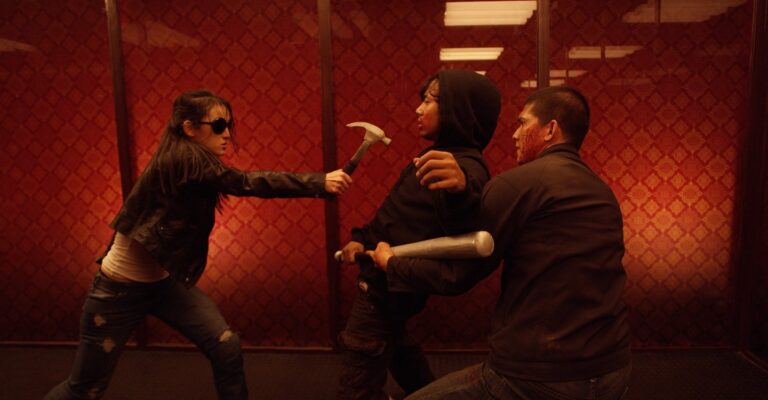
The Ultimate Action of Iko Uwais and Gareth Evans in ‘The Raid 2‘ (2014).

As taste and sensibility has evolved, so has the art we consume and create. Action filmmaking, arguably the most visceral of cinematic pleasures from the dawn of the medium of itself, is not immune to this evolution – in fact, it is deeply reflective of it. The past thirty years alone have borne witness to a marked change in the thrills and brutality of the action film, and no franchise better reflects our contemporary thirst for broken bones and blood than the deeply influential duology of Gareth Evans‘ The Raid series.
Shifting away from the high-flying, weightlessly intricate wire choreography that defined the action blockbusters of the late 1990s and early 2000s, The Raid films (featuring a now-iconic leading performance from Iko Uwais, the Pencak Silat master originally discovered by Evans’ and cast in his first prominent feature film, 2009’s Merantau) ground the viewer in the durability and destruction of the human form. No longer emphasizing the graceful movement and dance-like prowess of seemingly supernaturally skilled masters of combat, action cinema refocused itself for a new generation.
On-Screen Violence with a Fresh Purpose
With The Raid, on-screen violence took on a fresh purpose – depiction of survival at all costs. The unrelenting pain and viscerally of destroying the bodies of those opposed to our heroes (and villains), and the mental chess game of how to disable those who stand in your way as brutally, but more importantly, as efficiently as possible while minimizing the lasting damage taken to oneself. For the 2010s, action moved away from ballet, and far closer to UFC.
After the deep impact felt by 2011’s The Raid: Redemption, it would be an understatement to say that a sequel would be up against heavyweights. However, from the opening moments of The Raid 2, it is evident that Evans’ had no intention of fighting with the same strategy he had already so successfully established with his first round knockout.
By executing one of our protagonists from The Raid, Andi (portrayed brilliantly by Donny Alamsyah), the brother of our main character, Uwais’ moralistic Rama, Evans’ makes clear the thesis statement for his epic sequel – violence will always beget violence. Through the two-and-a-half hours of The Raid 2, this theme is explored not only textually, through the intricately woven story of a familial criminal empire eating its own tail like an ouroboros, but also through the technical filmmaking on display.
How the Raid 2 Masterfully Wears its Violence

The relentless nature of the violence depicted in The Raid 2 serves not just to thrill, but also to disturb – Evans’ horror bonafides (through his work directing a blood curdling segment of iconic found-footage horror film V/H/S/2, Safe Haven, and later with his deeply chilling Apostle) are nestled deep within the DNA of what makes The Raid franchise tick. The Raid 2 may be the most profound example of a filmmaker intentionally using the intensity and quality of his onscreen violence to deeply wear down the audience.
Within the film itself, Evans’ is constantly elevating from one action set piece to the next, and by the time the story has brought us into the third act, there is no sign of the brutality slowing down. When we finally reach a climax, the violence has culminated in such a way that instills the feeling that all of the lives taken, and all of the blood spilled, is simply another step in a vicious cycle that will always continue. The most horrific part of it all, was that despite the extreme actions taken by our altruistic hero, he didn’t even come close to making a dent.
In the final moments, when Rama, getting roped into more violence and pain by his superior officer, finally breaks the cycle, we do not feel relief. We feel the trauma of his experiences resonate through his bones.
The Raid 2 Changed the Ultimate Action Movie Game
https://www.youtube.com/watch?v=BPsR71CkJss
With The Raid 2 bringing the story of Uwais’ Rama to a blood-soaked and morally grey conclusion, Evans’ put a masterful capstone at the end of what has, in the years since, proven to be some of the most influential action cinema of all time. Without the raw carnage of The Raid franchise, equally thrilling western action masterworks like John Wick may never have been allowed to hit so hard, as the moviegoing audience’s thirst for such brutality may not have ever surfaced.
But, like sharks hungrily seeking a droplet of blood in a vast ocean, action fans know what they crave: as a result, we’re now lucky to be living in a time that will be considered a platinum age of action filmmaking. And, with the upcoming Gangs of London, Evans’ impact on the action sensibilities of our contemporary cinematic language will hopefully only continue to grow.